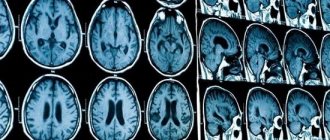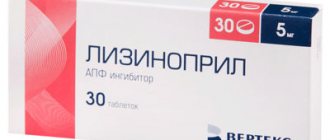Increased intracranial pressure in a child (arterial hypertension, intracranial hypertension) is a common disorder that can be a sign of various diseases. Intracranial pressure increases with brain tumors, hydrocephalus, neuroinfections (meningitis, encephalitis), intracerebral effusions, traumatic brain injuries, some hereditary pathologies and other diseases.
The development of arterial hypertension in a child is especially dangerous. Unstable pressure readings can cause serious abnormalities in brain development: mental retardation, blindness, paralysis and other pathological conditions.
Increased intracranial pressure is not always a sign of disorders. It can increase with everyday activities: defecation, coughing, stressful situations, suckling at the mother's breast, lifting heavy objects. It is not dangerous for the child. If intracranial pressure increases regularly and is permanent, parents and their child should seek medical help.
What is increased intracranial pressure?
Inside the brain there is a system of interconnected ventricles, which are also filled with cerebrospinal fluid (CSF). This protects the human brain from injuries, concussions, as much as possible. The pressure of cerebrospinal fluid on brain structures is called intracranial pressure. Exceeding the permissible norms entails a number of consequences.
The main question for parents is what are the signs of intracranial pressure in a child, and what threat does this pose to the child?
What complications can there be in children? If left untreated, increased intracranial pressure can lead to the following consequences: the occurrence of epileptic syndrome, blurred vision, mental disorders, strokes, disorders of consciousness, breathing problems, weakness in the limbs, etc.
What should parents of a child with this diagnosis know? ICP is not a disease, but only a symptom, a consequence of various diseases. There are several misconceptions among parents regarding increased intracranial pressure. For example, the fact that this is an incurable condition. However, with timely treatment, the child’s recovery is possible. The main thing that needs to be done is to consult a specialist in time and follow the doctor’s instructions.
Take note
A sign of increased intracranial pressure is not:
- increased muscle tone;
- pulsation of the parietal fontanel;
- the child supports or walks on the forefoot (toes, toes);
- tongue sticking out;
- restless sleep, frequent waking up and screaming in sleep;
- trembling (tremor) of the chin.
Article on the topic
Pediatrician secrets. What to do if a child complains of pain The following symptoms may indicate increased intracranial pressure:
- an increase or decrease in the size of the head by more than 3 cm from the norm (see table), however, it is important to look at the ratio of the head circumference to the chest;
- large size and tension of the parietal fontanel (when you touch it, it is tight);
- divergence of cranial sutures;
- significant changes in the fundus.
Symptoms of increased intracranial pressure
Increased intracranial pressure in children, symptoms of which can appear in the first minutes and hours after birth, often leads to the development of serious complications.
When parents may suspect something is wrong:
In young children:
- The baby constantly cries and does not calm down;
- Lack of thirst in the child, reluctance to drink;
- The baby is irritated by bright lights and sharp sounds;
- The child burps frequently and profusely;
- The baby's fontanel bulges;
- The baby's chin is shaking;
- Rapid head growth (this is due to stagnation of venous blood);
- The child throws his head back.
In older children
- Severe headaches;
- Nausea, vomiting;
- Increased fatigue, weakness;
- Drowsiness;
- Tearfulness, irritability;
- Apathy;
- Double vision.
Knowing the key signs of the disease, you can establish the correct diagnosis in the early stages and prescribe the correct treatment for your child. Even if you have only one of the listed symptoms, you need to immediately contact a neurologist! The sooner your baby receives help, the fewer consequences it will have for the child’s body in the future.
Characteristic symptoms
In children, signs of intracranial pressure may be nonspecific with small lesions of the cerebral ventricles. They can be confused with other symptoms that manifest many inflammatory pathologies. Therefore, hypertensive syndrome can usually be recognized by its clear clinical symptoms:
- enlargement of the skull in volume - this symptom is typical for newborns and infants with signs of ICP; in severe forms of the pathology, the head increases by several centimeters above normal;
- protrusion of the eyes - this leads to incomplete closure of the eyelids, during sleep the irises of the eyeballs are visible in the baby;
- pulsation manifested in the area of the large fontanelle - upon examination and palpation, it protrudes above the surface of the skull and looks swollen;
- a pronounced venous network on the head - high pressure provokes congestion of the veins, they are clearly visible on the surface of the skin;
- frequent regurgitation is a symptom characteristic of children in the first 2–3 months of life (due to compression of the nerve receptors responsible for the functions of important parts of the body, the baby regurgitates 3–4 times a day);
- deterioration of health - lying on his back, the child becomes capricious, cries, calming down only in his arms. This is explained by the overflow of the veins with blood in a horizontal position and an increase in the level of intracranial pressure;
- sleep disturbances – this symptom becomes pronounced in children aged 2 years and older (up to 6–7 years), the child’s sleep is superficial, he often wakes up and cannot rest for more than 1–2 hours in a row;
- disturbance of psychophysical development - the baby lags behind normal indicators, later begins to sit and crawl, speech functions suffer in comparison with peers.
An older child can already formulate his complaints - he is bothered by regular headaches of a diffuse nature, especially in the evening and at night.
The baby also complains of frequent attacks of nausea, sometimes ending in vomiting - but the condition does not improve, and the gag reflex is not associated with the food eaten the day before. Children of preschool and school age react to hypertensive syndrome with speech development disorders - they confuse words, speak poorly, have a lisp, and often require the help of a speech therapist.
Intellectual functions also suffer - the child has difficulty concentrating on studies, he is unable to solve complex problems. For these reasons, a schoolchild becomes prone to depression; he shows signs of nervousness, is constantly capricious, offended and cries. At the same time, the child’s appetite is impaired, which is why children with severe signs of ICP are often thin and petite.
Diagnosis of intracranial pressure
Before prescribing treatment for your child, we perform a comprehensive neurological examination. It includes:
- Collecting anamnesis (conversation with the mother, studying the child’s medical record, history of pregnancy and childbirth and the results of previous studies);
- special neurological tests;
- active and muscle tests;
- reflex diagnostics;
- local palpation examination of the spine and musculoskeletal system.
In addition to the main examination, if necessary, the doctor may prescribe:
- NSG (neurosonography, ultrasound of the brain);
- MRI;
- Ultrasound;
- X-ray;
- Lab tests;
- EEG;
Severe symptoms
Perhaps the main sign indicating this illness is the child’s restless behavior. The baby cannot sleep, cries all the time and does not even want to eat. He even vomits water.
In children, already at a few months old, external symptoms of increased intraocular pressure can be noticed and identified.
They are manifested by changes in the parameters of the child’s body:
- the head is disproportionately large;
- the frontal area is enlarged;
- the fontanel has signs of swelling;
- veins on the head;
- eyeballs are lowered too far;
- the child has problems gaining weight and slow reaction times;
- there are some developmental deviations;
- Sometimes frequent regurgitation also indicates an increase in IAP.
As your child grows, the symptoms become clearer and more pronounced. Having learned to speak, the child will be able to say that he is in pain, and it will be easier for parents to understand his condition.
Treatment of intracranial pressure
To treat our little patients, we use only painless, gentle treatment methods that do not cause discomfort to the baby.
We use methods:
- Transcranial micropolarization (TCMP) is the effect of a low-power direct electric current (less than 1 mA) on brain tissue in order to activate individual brain centers (speech, motor, psychomotor, etc.);
- Manual therapy;
- Osteopathy - treatment by the hands of a doctor, a gentle effect on the musculoskeletal system, nervous and vascular systems, internal organs;
- Acupuncture - exposure to biologically active points with microneedles;
- Pharmacopuncture - the introduction of medicinal drugs of natural origin to the source of the problem;
- Isometric kinesiotherapy - individual gymnastic techniques/exercises, according to indications, with elements of joint massage;
- Isometric kinesiotherapy using the Exart installation;
- Ozone therapy - treatment with active oxygen;
- Physiotherapy;
- Physiotherapy with enzyme preparations;
- Medical massage;
- Therapeutic droppers;
- Hirudotherapy - treatment with leeches;
- Botulinum therapy - treatment with botulinum toxin;
- Tsubotherapy is a gentle effect on the reflex points of the body.
Remember that with increased intracranial pressure in children, treatment should be comprehensive, individual and under the supervision of a doctor.
Memo to parents
Head and chest circumference standards
| Age | Head circumference | Chest circumference |
| 1 month | 38.0 cm | 37.5 cm |
| 2 months | 39.0 cm | 38.5 cm |
| 3 months | 40.0 cm | 39.5 cm |
| 4 months | 41.5 cm | 41.0 cm |
| 5 months | 42.5 cm | 42.0 cm |
| 6 months | 43.5 cm | 43.5 cm |
| 7 months | 44.0 cm | 44.5 cm |
| 8 months | 44.5 cm | 45.0 cm |
| 9 months | 45.0 cm | 45.5 cm |
| 10 months | 45.5 cm | 46.0 cm |
| 11 months | 46.0–46.5 cm | 46.5 cm |
| 12 months | 47–49.0 cm | 48–50 cm |
Diseases caused by increased intracranial pressure
Our pediatric neurology department will help you not only make a correct diagnosis, but also undergo a course of treatment if your child has:
- Hyperactivity (attention deficit hyperactivity disorder, ADHD);
- Cerebral palsy (cerebral palsy);
- Autism;
- Delayed psychomotor development;
- Delayed speech development;
- Speech defects;
- Stuttering;
- Nervous tics;
- Enuresis;
- Sleep disturbances (sleeps poorly, sleeps little, wakes up frequently, does not fall asleep for a long time);
- Hypertonicity;
- Pyramid syndrome (pyramidal insufficiency syndrome);
- Hypertensive syndrome;
- Hydrocephalus (hydrocephalic syndrome, dropsy of the brain);
- Perinatal encephalopathy (perinatal damage to the central nervous system, PEP, PPCNS);
- Minimal brain dysfunction (MCD).
Causes of intracranial pressure:
- Birth or traumatic brain injury;
- Prematurity, pathologies during pregnancy or childbirth;
- Untimely fusion of the skull bones in a child;
- Benign brain tumors, which lead to increased blood pressure and changes in brain structures;
- Malignant brain tumors;
- Meningitis;
- Encephalitis;
- Toxic cerebral edema;
- Hydrocephalus;
- Genetic abnormalities and defects of the cerebrospinal fluid tract;
- Traumatic brain injury;
- Intracerebral hemorrhage.
Diagnostic methods
Unfortunately, it is currently impossible to accurately measure intracranial pressure - there is no special device such as a tonometer that will show specific indicators. Therefore, when diagnosing pathology in a child, doctors use other laboratory and instrumental techniques, and also focus on the symptoms characteristic of the disease. Here is a list of diagnostic procedures that do not measure cerebrospinal fluid pressure in the brain and spinal cord, but record changes characteristic of hypertensive syndrome:
- Blood tests. They make it possible to detect the presence in the body of a pathogenic pathogen that penetrates the blood-brain barrier and contributes to infection of the meninges.
- Examination of cerebrospinal fluid (puncture). It is prescribed by a neurologist for important clinical indications and allows you to check whether there are hidden neuroinfections in the child’s body or whether there has been a spinal cord or brain injury.
- NSG (neurosonography). It is carried out to record pathological changes in the structures of the brain.
- Ultrasound of the head and blood vessels. Clearly describes defects in the structure of capillaries and determines the level of intracranial pressure.
- CT and MRI diagnostic methods are indicated for children with signs of birth injuries; they allow one to assess the influence of these factors on the condition of blood vessels and cerebral ventricles.
Magnetic resonance imaging for intracranial pressure is a very effective diagnostic method
The child is also advised to consult an ophthalmologist for an extensive fundus examination. The presence of hypertensive syndrome can be indirectly confirmed by recording the spasm of the capillaries located at the bottom of the eye.
Prevention of intracranial pressure in adults at home
Prevention of increased ICP is the prevention of various diseases affecting the cranial cavity.
This includes protection against infections that can affect the brain - vaccination against meningococcal and hemophilus influenzae infections, influenza vaccination. It is also necessary to treat various pathologies that can affect brain function. General recommendations are simple:
- follow a daily routine and lead the healthiest lifestyle possible;
- avoid head injuries;
- protect yourself from stress and nervous overload;
- Get enough sleep.
Modern methods of treatment
In some cases, the patient does not require treatment; he is observed and treated for the underlying disease, which caused the increase in ICP.
If it is necessary to treat pathology, two approaches are used - conservative and surgical.
Conservative interventions are carried out for those patients whose ICP elevation is chronic and there is no significant deterioration of the condition over time. The basis of treatment is drugs that have a diuretic effect, which reduce the volume of fluid in the head. The specific medicine is determined by the level of pressure and the situation. In severe and acute processes, osmotic diuretics (mannitol) are used, in chronic cases - furosemide, hydrochlorothiazide, spironalactone. While taking them, you need to drink a potassium preparation - Asparkam, Potassium orotate, Panangin.
Surgical methods for treating increased ICP depend on the stage and severity of the disease. In acute situations, craniotomy is performed to reduce fluid pressure on the brain and drain excess fluid. Special shunts (tubes) are installed as planned, which drain fluid from the brain into the abdominal cavity.
Prevention
In order to normalize intracranial pressure, preventive measures should be taken.
It is recommended to adhere to the following rules:
- Adhere to the healthy lifestyle your child needs. Feed him in a timely manner and put him back to bed.
- Be sure to ventilate the room from time to time.
- Create a loving atmosphere in your home to give your baby positive emotions.
- Always use breast milk, which contains all the nutrients your baby needs.
To prevent negative consequences from high intracranial pressure, it is necessary to monitor any changes and manifestations in the child’s behavior. At the first suspicion, contact your doctor for advice. If the fears are confirmed, it will be possible to start treatment earlier and avoid unnecessary problems.
Main directions of treatment
As soon as it is determined that the child has increased intracranial pressure, consultation with the attending physician is necessary. After conducting the necessary examinations and tests, he will analyze the child’s condition and decide what to do next and what treatment regimen to prescribe.
Treatment of the disease can begin only after eliminating the causes that provoked it.
Otherwise, it will be ineffective and the likelihood of recurrence of attacks will continue. As a rule, therapy lasts several months.
The following elements are often prescribed in complex therapy:
- Taking diuretics. They help quickly remove excess fluid from the body. Harmful substances that improve the child’s well-being are removed along with it. These include products such as Furosemide, glycerin, a decoction of blueberry and parsley leaves.
- Using nootropics. They stimulate brain function. These are Actovegin, Pantogam and other drugs. They are prescribed in courses.
- Carrying out a relaxing massage. Improves blood flow and strengthens the walls of blood vessels. Children require at least 10 procedures several times a year - 2-3 times a year for 10-14 procedures.
- Procedures using tempered water, which have a beneficial effect on the movement of cerebrospinal fluid.
- Use of antiviral and antibacterial drugs.
- Use antiemetics if necessary.
- Taking a balanced multivitamin complex.
- Sedatives are prescribed to relieve nervousness.
In addition, it is recommended to follow the diet to ensure that it contains all the microelements the child needs. It is also important to follow a daily routine, take your child out for a walk and put him to bed on time.
The most extreme measure used in cases of brain injury is surgery. The operation is performed to restore the correct position of the bone structures and remove hematomas inside the skull.
Definition and physiological norms of ICP
Intracranial pressure is the pressure that is formed in the cranial cavity under the influence of several anatomical structures, namely: blood volume, intracerebral fluid and brain tissue.
Normally, intracranial pressure indicators fluctuate within the following limits:
- in adults (3-15 mm Hg);
- in children aged 1 to 15 years (3-7 mm Hg);
- in newborns and children under 1 year (1.5 – 6 mm Hg).
These values are typical for people at rest, since during physical activity accompanied by muscle tension, a short-term increase in values up to 50-60 mm occurs. rt. Art. The phenomenon is due to the activation of compensatory mechanisms for adequate functioning of the central nervous system. Manifestations of increased cerebral pressure are diagnosed when compensatory mechanisms are disrupted when they cannot cope with the increase in values.
What can cause brain pathologies?
The main cause of ICP in infants is hydrocephalus, which occurs due to increased production of cerebrospinal fluid.
As a result, excess fluid accumulates in various parts of the brain, disrupting the normal patency and absorption of cerebrospinal fluid. Typically, hydrocephalus in the fetus begins to develop in the last months of a woman’s pregnancy. Symptoms of this congenital disease can be detected immediately after birth. If treatment is started in a timely manner, there is every chance that the child’s cranial pressure will soon return to normal.
There are cases when cranial pressure in an infant increases gradually, the reason for this may be:
- a genetic or chromosomal disorder that causes congenital neurological defects;
- very early birth, when the child’s cerebral cortex has not yet fully formed;
- difficult pregnancy with pathologies;
- intrauterine infectious disease transmitted to the child from the mother;
- birth injuries to the head or concussion.
Among the diseases accompanied by the development of ICP, the most common are:
- encephalopathy and hydrocephalus;
- neuroinfectious diseases (meningitis, encephalitis, etc.);
- severe disturbance of metabolic processes in the body, leading to diabetes mellitus and hypothyroidism;
- brain tumor.










